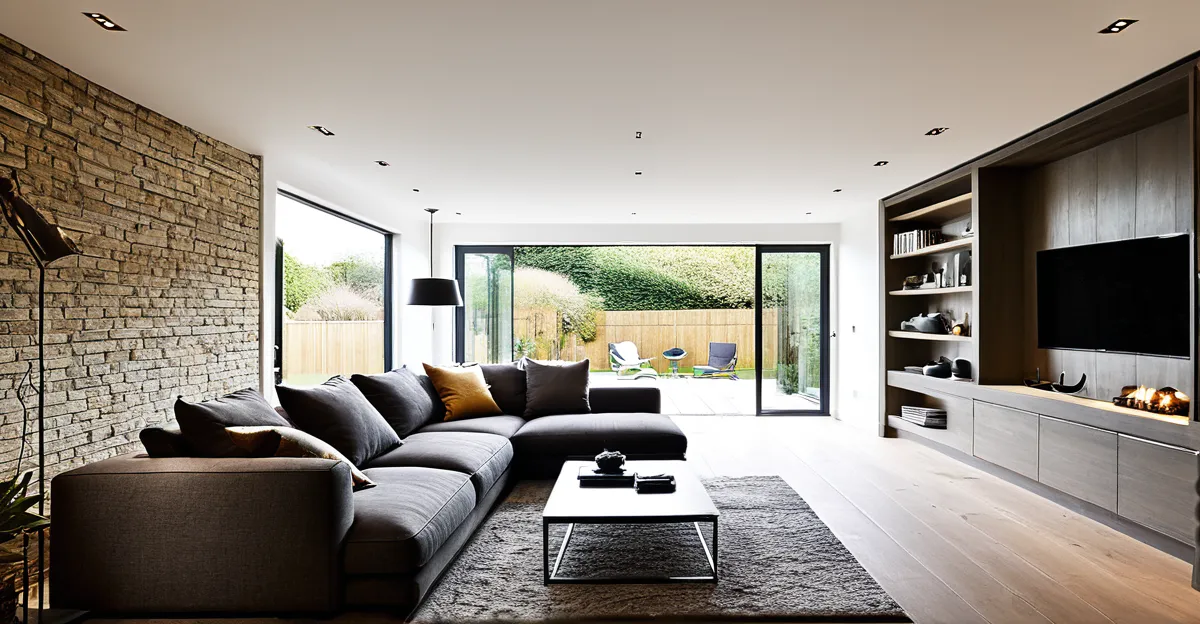Understanding Comfort in Home Design
Creating a sense of comfort in home design is integral to crafting spaces where individuals feel at ease. In the context of UK homes, comfort extends beyond physical warmth to encompass psychological and emotional well-being. It encompasses a fusion of aesthetic appeal and personal resonance within one’s living environment.
Cozy Interiors play a crucial role by integrating elements that cater to personal preferences and lifestyles, ensuring that a home feels uniquely tailored to its occupants. The choices in colors, materials, and even spatial layouts are often dictated by what makes an individual feel most at peace and content. Appreciating these personal nuances is essential for designing spaces that truly reflect comfort.
Also to read : How can you choose the right furniture for UK home living?
Moreover, the UK climate significantly influences how comfort is perceived and achieved in home design. Seasonal changes necessitate adaptable interiors that can provide warmth in winters while offering ventilation during milder summers. This adaptability ensures a consistent sense of cozy ambiance throughout the year, regardless of external weather conditions.
In essence, understanding and implementing comfort in home design requires a thoughtful synthesis of personal desires, practical functionality, and environmental considerations. Being aware of these elements aids in crafting interiors that not only look appealing but also serve as sanctuaries for rest and rejuvenation.
This might interest you : What are the key features of a sustainable UK home design?
Key Strategies for Enhancing Interior Comfort
Creating a cozy atmosphere at home is a multifaceted challenge that involves careful consideration of numerous elements. By focusing on effectively optimizing the space, choosing appropriate furniture, and incorporating textiles keenly, you can ensure enhanced interior comfort.
Utilizing Space Effectively
The layout of a room plays a critical role in making any space feel comfortable and functional, whether dealing with spacious environments or more compact areas. In smaller spaces, it’s essential to prioritize traffic flow and facilitate ease of movement, while in larger rooms, defining zones with furniture can add coziness. Open living spaces lend an airy feel but might require creativity in dividing areas without walls to maintain a sense of intimacy. On the contrary, closed spaces can offer privacy and a more focused atmosphere, which some might find more comfortable.
Choosing the Right Furniture
Comfortable and supportive furniture is the backbone of any cozy interior. Consider pieces that not only fit the room’s scale and proportion but also offer flexibility, such as multi-functional furniture. Think of sofas with storage or extendable tables that can cater to various needs. These selections can transform how a room is used, enhancing both functionality and comfort.
Incorporating Textiles
Textiles are pivotal to a room’s comfort by adding layers of warmth and softness. Utilizing a variety of textiles, such as plush rugs, throw blankets, and soft cushions, can nurture a snug and inviting environment. Employing layering techniques further accentuates a cozy setting, making your living space feel even more homely. Opt for texture-rich fabrics such as wool, linen, or velvet to inject additional visual and tactile comfort into the space.
Incorporating these strategies can significantly elevate the comfort levels of interior spaces by aligning them with personal preferences and lifestyle needs while maintaining a cozy atmosphere.
Lighting Techniques to Elevate Comfort
Creating a serene and cozy atmosphere within your home is significantly influenced by the lighting choices you make. Thoughtfully curated lighting for comfort can transform any space, ensuring it feels warm, inviting, and functional.
Natural Light Utilization
Natural light is a cornerstone of home comfort, bringing warmth and vitality to your living space. To maximize the natural light flow, consider positioning mirrors strategically to reflect sunlight deeper into rooms. Employ sheer window treatments that permit ample sunlight while maintaining privacy. The benefits extend beyond mere aesthetics; exposure to natural light improves mood and well-being, fostering a relaxed environment.
Layered Lighting Solutions
Incorporating different light sources is essential for creating distinction and depth in your home. Layered lighting involves combining ambient, task, and accent lighting to cater to varied needs. Ambient lighting provides general illumination, task lighting focuses on specific areas for activities, and accent lighting highlights architectural features or artwork. Opting for warm light temperatures enhances comfort, making spaces appear cozier, while cooler tones suit areas that require more focus, like kitchens or studies.
Smart Lighting Technologies
Integrating smart lighting systems elevates adaptability and personalization in your lighting scheme. These systems offer features like dimming and color changes at the touch of a button, enhancing both energy efficiency and user experience. Options for control include voice commands, apps, and timers, allowing you to tailor the lighting to fit different activities and times of day. This fusion of technology with design ensures lighting not only serves functional purposes but also aligns with personal comfort preferences.
Color Schemes that Promote Comfort
Choosing the right color scheme is crucial in promoting a sense of comfort and tranquility within UK homes. By understanding how colors influence mood and atmosphere, one can design spaces that truly resonate with personal and familial needs.
Understanding Color Psychology
Colors have a profound effect on the ambience and emotional tone of a space. In UK home design, softer tones such as light blues and greens are often favored for their calming effects, while warmer hues like deep reds or rich browns can create a cozy atmosphere. Balancing bold tones with neutral shades is essential to avoid overwhelming the senses. Integrating these colors thoughtfully contributes to a harmonious and inviting environment tailored to the preferences of occupants.
Creating a Cohesive Palette
Maintaining a cohesive color palette throughout the home ensures a seamless visual flow, enhancing both comfort and aesthetic appeal. When selecting colors, consider combining textures and patterns to add depth and interest without disrupting the overall scheme. Opt for seasonal updates to refresh the look; introducing warm colors in the winter can evoke coziness, while cooler hues in the summer can instill freshness. This adaptability allows the home to feel comfortable year-round.
Accent Walls and Features
Implementing accent walls is an effective way to add character and dimension to various rooms. These focal points can be painted in bold, contrasting colors or adorned with artwork that aligns with the overall color scheme. In living areas, deep shades can create intimacy, while in bathrooms or kitchens, vibrant hues might be used to energize the space. Accent features effectively break up monotony and offer an opportunity to express individuality within an integrated design framework.
Climate Considerations for UK Homes
In the context of the UK climate, ensuring home comfort requires thoughtful adaptations to cope with distinct seasonal changes. The fluctuating weather patterns necessitate versatile interiors that can provide both warmth in winters and coolness in the warmer months, optimizing energy use and personal comfort.
Adapting Interiors for Seasonal Changes
Adapting your home to the UK’s seasonal ebb and flow involves strategies that focus on insulation and heat retention during colder months. Effective insulation in walls, roofs, and floors can significantly improve warmth retention. Additionally, double-glazed windows hinder heat loss while providing sound insulation. In contrast, during milder summers, strategies for cooling such as cross-ventilation, solar shading, and reflective window films can help maintain comfortable indoor temperatures. Ceiling fans and air conditioners, when used judiciously, further enhance comfort without excessive energy use.
Energy Efficiency in Design
Incorporating energy-efficient appliances and systems is crucial for both comfort and cost-effectiveness in UK homes. Modern appliances designed to consume less energy, along with smart thermostats, can optimize heating efficiency while reducing utility bills. Utilizing renewable energy sources like solar panels also contributes to long-term savings and environmental sustainability. Employing sustainable practices in home maintenance, such as regular servicing of heating and cooling systems, ensures their optimal performance and extends their lifespan.
Local Influences on Design Choices
Local influences greatly impact design choices in UK homes, as varying regional aesthetics inform preferences and functionality. Some homes integrate traditional materials and methods, such as stone cladding or wooden structures, reflecting local heritage. Case studies of UK homes reveal great diversity in adapting to climate challenges and maximizing comfort. For example, Yorkshire cottages often incorporate thick stone walls to buffer weather variations, whereas modern London flats might rely on contemporary insulation technologies. Recognizing these unique needs and integrating local materials and traditions enriches the overall comfort and appeal of homes, aligning beautifully with the UK’s varied climates.
Sustainable Materials for Interior Comfort
Embracing sustainable interior design not only fosters environmental responsibility but also significantly enhances the comfort and well-being within a home. Incorporating eco-friendly materials can make a substantial difference in creating serene and healthy living spaces.
Benefits of Sustainable Materials
Sustainable materials contribute positively to the environment, reducing waste and carbon footprints. Their usage also ensures healthier indoor air quality, as many are free from toxic chemicals found in traditional materials. These materials, including those with eco-friendly sourcing, are known for their durability, which means they offer long-lasting solutions while minimizing the need for frequent replacements. This consideration of longevity and durability becomes essential in building a sustainable home environment.
Popular Sustainable Material Options
When considering eco-friendly materials, wood, bamboo, and cork stand out for flooring and furniture due to their renewable nature. Recycled textiles offer versatile applications in upholstery and curtains, aligning perfectly with sustainability goals. Furthermore, opting for low-VOC paints and finishes ensures reduced chemical emissions, contributing to a healthier home atmosphere.
Incorporating Biophilic Design
The biophilic design approach emphasizes the integration of natural elements indoors to enhance comfort and aesthetics. Incorporating indoor plants and green walls not only beautifies the space but actively improves air quality. These elements provide a tangible connection to nature, fostering a sense of tranquility and well-being. This thoughtful inclusion of nature indoors exemplifies the potential of sustainable design in enhancing overall home comfort.







